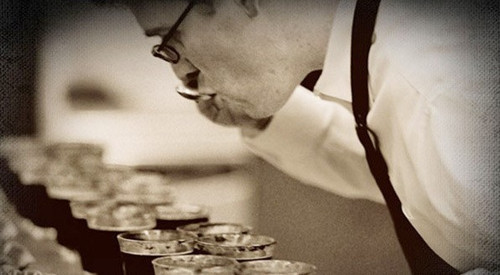Many determinants of a good cup of coffee the choice of a coffee maker

The choice of coffee maker
1. Boiler capacity: if the boiler capacity is large, the effluent temperature is stable and the coffee quality is stable.
two。 Coffee machine temperature: whether it remains stable or not also affects the quality of coffee.
3. Atmospheric pressure: it is ideal to make coffee with nine air pressure values.
4. Effluent temperature: the international standard coffee machine effluent temperature is 90 °C, which should also be adjusted according to the roasting degree of coffee beans. If the roasting degree of coffee beans is deeper, the effluent temperature of the coffee machine will be reduced, otherwise the extracted coffee is easy to have scorched and bitter taste. The SPR used in the store is suitable for production with effluent temperature from 90 °C to 91 °C.
Note: the effluent temperature of coffee production refers to the outlet temperature of the machine head, which is different from the direct hot water output temperature of the boiler.
The choice of coffee beans
The main characteristics of 1.Arabica (also known as Gaoshan bean): the fragrant smell is strong; it is not easy to have a bitter taste; the content of Creama (coffee oil) is moderate; the acidity is high; and the caffeine content is 30% of Robusta.
The main characteristics of 2.Robusta: poor aroma; bitter taste after deep roasting; more Creama (coffee oil); low acidity; high caffeine content.
Preservation of coffee beans
1. Unopened coffee beans: suitable for preservation in a cool, well-ventilated environment at a temperature of 18 °C-22 °C. Try not to put it in a dry place (the humidity is too dry below 54%), so its storage environment is similar to that of red wine.
two。 Coffee beans that have been opened: when the coffee beans come into contact with the air, their flavor begins to lose, while the area of a complete coffee bean in contact with the air is limited, but the coffee bean forms a powder after grinding, and countless noodles come into contact with the air. so that the loss of flavor is accelerated. Therefore, when making coffee, grind and use it as much as possible, so as to ensure the quality of each cup of coffee. As for the preservation of open coffee beans, it is suitable for sealed preservation, but do not put them in a too humid environment, because coffee beans are afraid of moisture, and the oil of coffee beans is easy to lose, and the flavor will become worse.
Key points for the preservation of coffee beans: whether coffee beans are opened or not, they are afraid that the environmental humidity is too high. Coffee beans, whether opened or not, their preservation environment can not be mixed, especially not suitable for storage in the refrigerator. After the coffee beans are opened, as long as the packaging is sealed correctly, it can be accepted for use within three days (the longest is no more than five days), but also pay attention to the preservation environment. Ground coffee beans are best used immediately.
Human factors
1. The base espresso:Barista (barista) should know how to use espresso, because as long as the espresso is made perfectly, other fancy coffee is easy to ensure its quality, so espresso is the foundation of Italian coffee; so if you want to master espresso, you must first learn how to drink and taste espresso.
two。 Familiar with the machine: Barista must have a considerable degree of coffee professional knowledge and professionalism, and must have a considerable understanding of the coffee machine used. Only when you can skillfully master the performance of the machine can you make a good cup of coffee.
3. Professional production skills: professional training and continuous practice, in order to achieve the correct and skilled skills, so that the quality of each cup of coffee can be guaranteed.
4. Espresso extraction time: a cup of 25cc to 30cc espresso, the standard extraction time is 25 seconds, but it is also considered a reasonable extraction time in the range of 22 seconds to 28 seconds, so that the quality of coffee can be controlled.
5. The factors affecting the extraction time of espresso:
Selection of coffee beans and adjustment of grinding thickness: theoretically, deep roasted beans are thicker and medium roasted beans are finer, so adjusting the grinding thickness of coffee beans is one of the important factors.
The standard of coffee powder: generally speaking, the amount of powder used in each cup of Singer espresso is 7g to 9g, which depends on the flavor orientation of coffee and the preference of consumers to determine the concentration of extracted espresso.
Pressing powder: the pressure of filling coffee powder in the handle of the coffee machine must be very accurate. It is necessary to fill the coffee powder to the most solid degree before you can card the handle on the head of the machine and extract espresso. It is more correct to fill and press 3 to 4 times with appropriate pressure and rotation left and right.
Changes in the environment
1. Temperature change: the higher the external temperature, the finer the coffee beans will be ground; otherwise, the coffee beans will be ground coarsely. Generally speaking, the environment for coffee production is 18 to 23 degrees.
two。 Changes in humidity: the greater the humidity, the thicker the coffee beans are ground. Compared with temperature and humidity, coffee production is mainly affected by ambient temperature.
3. Water quality requirements: generally speaking, 70ppm (proportion of mineral content in water) below is soft water, and above 70ppm is hard water. The higher the mineral content in the water, the heavier the miscellaneous smell of coffee, so it is recommended to use 60ppm to 140ppm water quality to ensure that the coffee is mellow.
Important Notice :
前街咖啡 FrontStreet Coffee has moved to new addredd:
FrontStreet Coffee Address: 315,Donghua East Road,GuangZhou
Tel:020 38364473
- Prev

Basic knowledge of fine coffee roasted by charcoal fire
This roasting method of charcoal coffee is a unique coffee roasting method in Japan. The coffee is soft and mild, with charcoal aroma that is characteristic of this baking. The disadvantages of using charcoal to bake coffee: the cost of using charcoal is higher than that of gas, the production is small, and it is difficult to adjust the firepower of charcoal. It is better to use long fruit wood carbon; bamboo charcoal has stronger firepower and far infrared than charcoal. Charcoal burning and gas roasting coffee beans, there are very
- Next

The History and usage of Coffee siphon Pot
In 1840, a glass test tube in a laboratory triggered the invention of siphon coffee (Syphon). The British took the test tube used in Biya's chemical experiment as a model to create the first vacuum coffee pot. Two years later, Mrs. Bachang of France improved the kettle with a little spring in shape, and the familiar upper and lower convection siphon pot was born. Siphon coffee maker in France
Related
- Beginners will see the "Coffee pull flower" guide!
- What is the difference between ice blog purified milk and ordinary milk coffee?
- Why is the Philippines the largest producer of crops in Liberia?
- For coffee extraction, should the fine powder be retained?
- How does extracted espresso fill pressed powder? How much strength does it take to press the powder?
- How to make jasmine cold extract coffee? Is the jasmine + latte good?
- Will this little toy really make the coffee taste better? How does Lily Drip affect coffee extraction?
- Will the action of slapping the filter cup also affect coffee extraction?
- What's the difference between powder-to-water ratio and powder-to-liquid ratio?
- What is the Ethiopian local species? What does it have to do with Heirloom native species?

